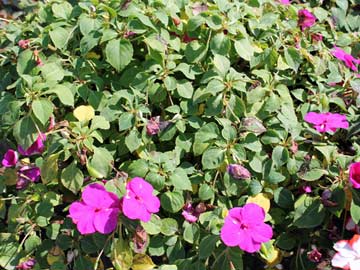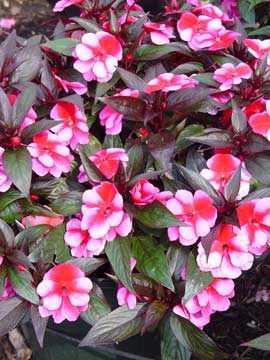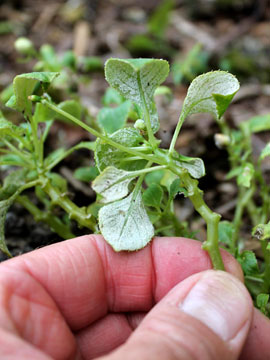As summer peaked in 2012, gardeners across much of the United States saw their normally reliable plantings of impatiens mysteriously wilt and die en masse. The culprit turned out to be a deadly and fast-spreading disease called downy mildew that suddenly flared, decimating America’s No. 1 annual shade flower in 33 states. Growers and plant pathologists feared the worst. Since the disease organism travels readily on wind and rain and can persist in the soil, warnings went out that impatiens likely would be a poor risk for at least the near future. Growers cut back production, and some garden centers stopped selling them altogether.
 A patch of bedding impatiens losing bloom and turning yellow in the early stages of a downy mildew infection.
A patch of bedding impatiens losing bloom and turning yellow in the early stages of a downy mildew infection.
© George Weigel
Then something unexpected happened in 2013. For once, instead of another unforeseen problem blind-siding gardeners, an expected problem didn’t pan out. Downy mildew killed some impatiens in about a dozen states, but the incidence was far less, and it occurred later in the season. Plant pathologists say one reason was the weather was less conducive to infection in 2013 than in 2012 in much of the country. Drier spring weather in particular can hamper or delay a downy mildew outbreak. Another factor was that far fewer impatiens ended up in the ground as home gardeners saw the garden-center warning signs or were impatiens-shy after their own 2012 plantings died. "Plants that aren’t there don’t get sick and die… or spread spores to other plants," explained Chris Wallen, a grower at Quality Greenhouses near Dillsburg, PA.
 New Guinea impatiens are larger versions of bedding impatiens that are apparently immune to downy mildew disease. This one is 'Rose Star'.
New Guinea impatiens are larger versions of bedding impatiens that are apparently immune to downy mildew disease. This one is 'Rose Star'.
© George Weigel
So what are gardeners to make of this as they plan this spring’s flower choices? One lesson is that the arrival of downy mildew doesn’t guarantee death. It’s definitely a threat that makes impatiens survival and performance more risky than before, but the severity can vary from season to season. One alternative is switching to types of impatiens that are apparently immune to this disease, which has no cure once it infects a plant in the home garden. New Guinea impatiens and a hybrid line of impatiens called SunPatiens are resistant to this strain of downy mildew. Most prone is the top-selling "bedding" impatiens or Impatiens walleriana, typically sold in 4-packs and 6-packs for $2 to $4.
Many plant breeders are already at work on developing additional lines of mildew-resistant impatiens. Another option is switching to other species of shade-tolerant annuals. These include begonia, coleus, wishbone flower (Torenia), browallia, caladium and ivy geranium. Downy mildew doesn’t affect any of those. An alternative approach is to use a mix of choices -in other words, never putting all of your eggs in any one basket. In gardening, that’s a "monoculture," and the risk is that if a bug or disease comes along that likes your singular choice, you lose the whole shebang.
 A telltale sign of downy mildew is the whitish-gray coating on the undersides of impatiens leaves.
A telltale sign of downy mildew is the whitish-gray coating on the undersides of impatiens leaves.
© George Weigel
If you go with mildew-prone impatiens, avoid watering them over the top of the foliage, and keep them as healthy as possible by planting in afternoon shade in loose, compost-enriched soil and with added plant food. Some gardeners reported in 2013 that their bedding impatiens did better in pots and window boxes than in the ground. That could be because drainage is generally better in those settings, and containers can be grown with new, disease-free, soilless potting mix each season.
The pathogen that causes downy mildew is a water mold that’s been known since the 1800s. It didn’t begin devastating garden impatiens until about a dozen years ago when Europe was widely affected. The disease is still entrenched there. Downy mildew infected impatiens on a small scale in the United States starting in 2004 before suddenly flaring in 2012. The disease also infects native jewelweed, which is in the impatiens family. The usual first sign is stunted growth along with leaves that start to yellow, wilt and curl. A telltale sign is a whitish-gray coating on the leaf undersides. As the disease progresses – often within a matter of weeks – the plants go completely limp and die.